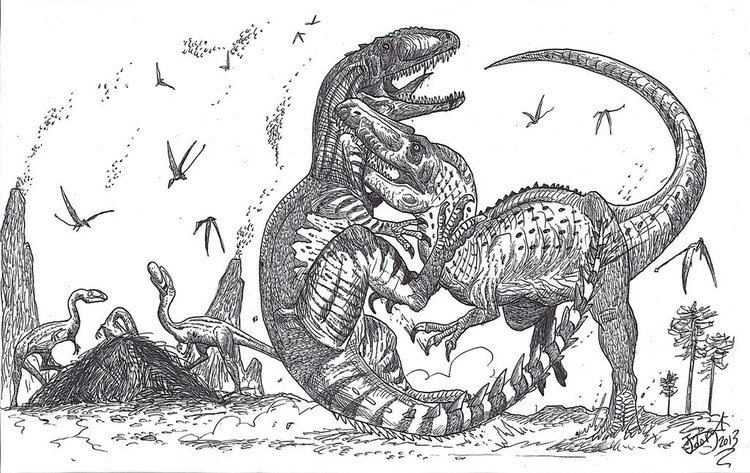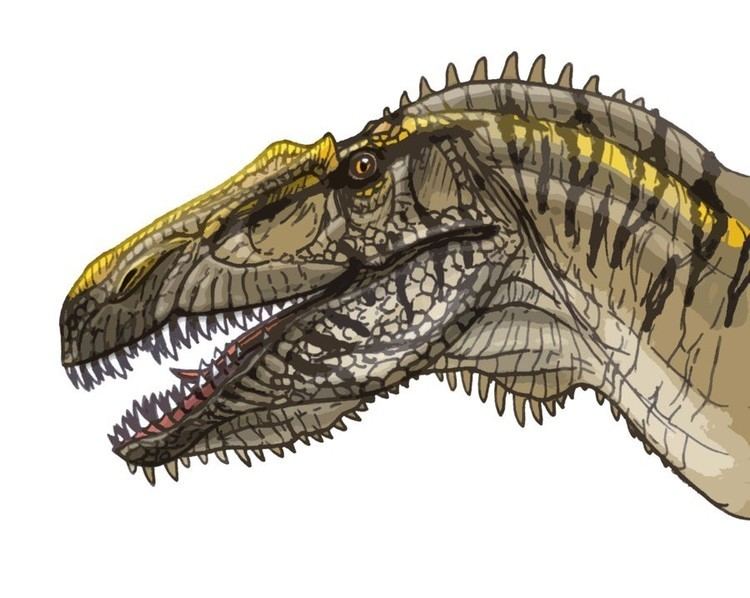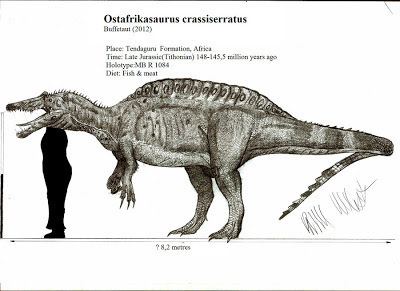Kingdom Animalia Clade Dinosauria Suborder Theropoda Scientific name Ostafrikasaurus Rank Genus | Phylum Chordata Order Saurischia Family †Spinosauridae Higher classification Spinosauridae | |
 | ||
Similar Dinosaur, Irritator, Spinosauridae, Veterupristisaurus, Suchomimus | ||
Battle carnage irritator vs ostafrikasaurus
Ostafrikasaurus is a genus of spinosaurid theropod dinosaurs known from the Jurassic of Tendaguru, southeastern Tanzania. It contains a single species, Ostafrikasaurus crassiserratus.
Contents
- Battle carnage irritator vs ostafrikasaurus
- Dinosaurs unearthed ostafrikasaurus early spinosaurid documentary
- Discovery
- Description
- Phylogeny
- Etymology
- References

Dinosaurs unearthed ostafrikasaurus early spinosaurid documentary
Discovery

Ostafrikasaurus is only known from the holotype specimen MB R 1084, an isolated tooth. It was originally referred to Labrosaurus? stechowi by Werner Janensch in 1920. All teeth assigned to L.? stechowi were collected by German expeditions from 1909 to 1913 from the area around Tendaguru hill in southeastern Tanzania, German East Africa. Janensch (1925) described a total of nine teeth, which he assigned to L.? stechowi (holotype MB R 1083) and divided them into five types. Later the teeth were reassigned to ?Ceratosaurus stechowi, as Labrosaurus found to be a junior synonym of Allosaurus. Recent studies usually suggest that Labrosaurus stechowi is a nomen dubium, and that these teeth are indeterminate, perhaps representing different taxa.

MB R 1084, which is the only teeth from the Upper Dinosaur Marl (Obere Dinosauriermergel) of the Tendaguru Formation, differs in several respects from the other teeth, from the Middle Dinosaur Marl (Mittlere Dinosauriermergel). Although Buffetaut in 2008 suggested that another isolated tooth, MB R 1091 collected from the Middle Dinosaur Marl, may also represent the same genus as MB R 1084, Buffetaut when naming Ostafrikasaurus in 2012 did not refer it to the genus. The Upper Dinosaur Marl of the Tendaguru Formation dates back to the middle and late Tithonian faunal stage of the Late Jurassic, about 148-145.5 million years ago.
Description
Ostafrikasaurus is based on a thick and serrated tooth which is about 49 mm (1.9 in) in length. Buffetaut (2008) suggested that this tooth represents a new genus of Spinosauridae, and that it differs from other teeth previously referred to L.? stechowi. Oliver Rauhut (2011) listed some of these differences: MB R 1084 has a much higher number of lingual ridges (up to eleven) and presents three ridges and grooves on the labial side. Furthermore, some of the lingual ridges extend over almost the entire length of the crown, leaving only the apicalmost 5 mm of the crown smooth, whereas others are restricted to the basal part, being intercalated with ridges that extend further apically. Additionally, ridges are present over almost the entire mesial (front) threefifths of the crown, whereas the distal (back) two-fifths are devoid of any ornamentation. Mesially, the ridged area is slightly set off from the mesial carina by a slightly mesiodistally concave area. However, its general shape and serration density is very similar to the teeth from the Middle Dinosaur Marl, as all teeth have 10 denticles per 5 mm distally and 13 denticles per 5 mm mesially. Finally, Rauhut suggested that it is possible that this tooth represents the same taxon as the other teeth, or a closely related taxon. The size of Ostafrikasaurus size is estimated between 8 and 10 meters (26 and 33 ft) long and two tons in weight.
Phylogeny
Buffetaut in 2012 assigned Ostafrikasaurus to the Spinosauridae, based on the fact that the tooth displays an enamel ornamentation that resembles many baryonychines including Baryonyx, but differs from all other known spinosaurids by the large size of the denticles borne by the carinae. Thus, Ostafrikasaurus, according to Buffetaut, represents the earliest currently known spinosaurid. The tooth suggests that the dental evolution of spinosaurids have been characterised by reduction of the denticles.Ostafrikasaurus, although not always assigned to the Spinosauridae, undoubtedly is older than any known spinosaurid.
Etymology
Ostafrikasaurus was first described and named by Eric Buffetaut in 2012 and the type species is Ostafrikasaurus crassiserratus. The generic name is derived from Deutsch-Ostafrika (or German East Africa, a German colony in East Africa, which included what are now Burundi, Rwanda and Tanganyika) in which the holotype was found, from the Greek σαῦρος, sauros meaning "lizard". The specific name is derived from the Latin crassus, meaning "thick" and serratus, "serrated" in reference to the shape of the holotype tooth.
